Low-Maintenance Landscaping for Missouri
BY FARAH NAUMAN | MAY 15TH, 2023 | LAWN CARE, MISSOURILawn maintenance is no joke. There’s a lot of time, tools, planning, sweat, and hard work involved in getting a lawn to look great all seasons of the year. Makes you wonder if it’s even possible to achieve an all-year green landscape, right?
It is. Consider incorporating low-maintenance landscaping for your Missouri yard and save tons of exhausting upkeep hours. Low-care landscaping is simply just using plants that don’t require much mowing, fertilizing, watering, weeding, or pest control and, consequently, cutting down your maintenance costs and time.
In this article, we will explore these 10 low-maintenance landscaping ideas:
- Incorporate Hardscape Features
- Arrange or Rearrange Plants Wisely
- Consider Turf Alternatives
- Plant Missouri Natives
- Use Mulches
- Reduce Size
- Keep the Design Simple
- More Outdoor Living Spaces
- Go for Xeriscaping
- Use More Perennials
1. Incorporate Hardscape Features
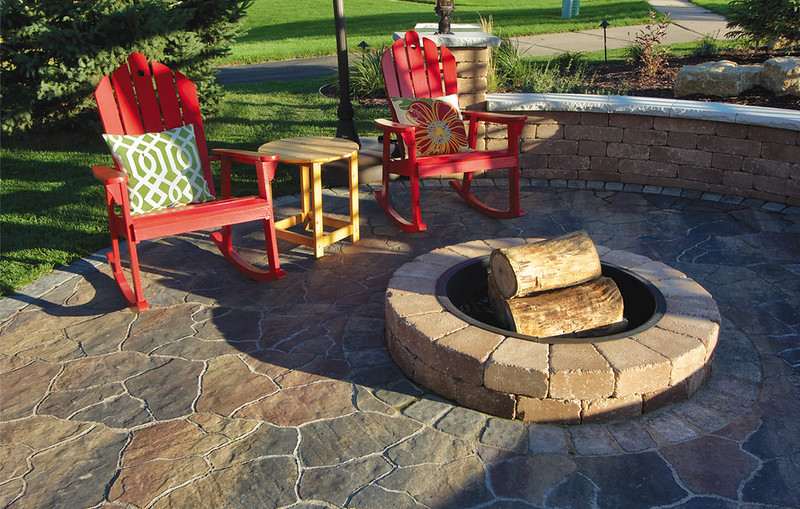
Photo Credit: Rochester Concrete Products / Flickr / CC BY 2.0
Patios, decks, and other such hard surfaces add a nice, long-lasting usable living space in your house. Not to mention, they require little to no maintenance. For instance, concrete pavers give a more structured and cleaner look for spaces like walkways, and the upkeep is relatively easier than other alternatives.
You can also incorporate fences, sidewalks, and edging around beds to minimize the need for hand trimming. Also, make sure you keep the edges of these hard surfaces flat and low to eliminate the need for hand edging when using a power mower – it can easily ride over if the surface is flat, saving you time and energy.
Other examples of hardscapes that make a great addition to any yard include:
- Stone pavers
- Decorative boulders
- Fire pits
- Rock gardens
- Parking spaces
Adding more hardscapes to your home also means you will have fewer living plants to tend to. This means less mowing, pruning, watering, weeding, or dealing with pests. All you have to do is do some occasional cleaning.
Advantages of Hardscapes:
- Boost home value
- Easy to look after
- Save water
2. Arrange or Rearrange Plants Wisely
The position and placement of plants, whether they are potted or planted, are important. If plants in your yard are scattered, they need more care than plants that are massed in groups. You will have to expend more time hand-edging and trimming individual plants if they’re apart.
Plus, flaws on a single shrub, tree, or flower will stand out more and call for immediate remedy whereas plants in clusters easily conceal each other’s shortcomings. Periodic maintenance of packed-together plants also costs you less, both in terms of money and time.
Group plants that have the same environmental preferences instead of planting a variety of plants with dissimilar needs.
Advantages of Grouping Plants:
- Achieves a well-put-together look
- Easy to tend to
- Accompanying plants act as living mulch for each other
- Reduces water usage
3. Consider Turf Alternatives
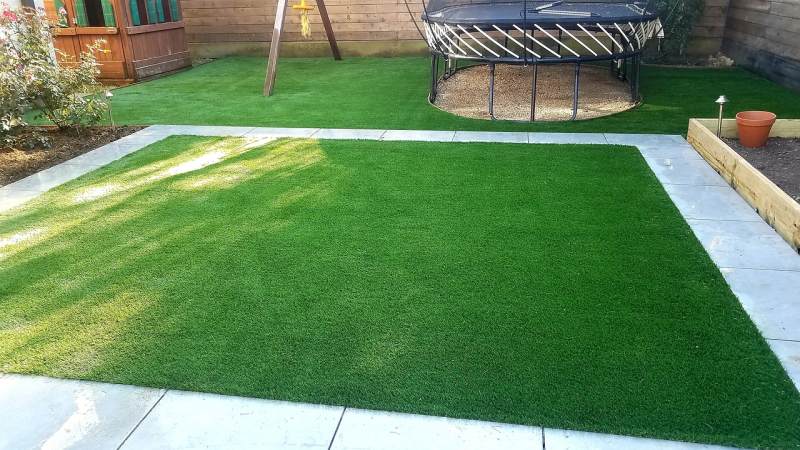
Photo Credit: Pixabay
The most prominent and largest part of almost every Missouri landscape is grass. It’s the base. Grass adds the texture, color, scent, and comfort that a lawn needs. But this turf also requires consistent care and maintenance to look its best.
Try to reduce grassy areas in your landscape if you’re looking to cut some maintenance costs. Lawn alternatives, such as artificial turf, do not require water, mulch, fertilizer, or sunlight to stay alive and green.
Synthetic grass looks real (you can barely tell the difference), stays fluffy, and need no maintenance at all. The initial cost may seem a bit high, but it’s a worthwhile investment.
Advantages of Lawn Alternatives:
- No pest or disease problems
- Saves water
- Saves cost to fertilize, thatch, aerate, etc.
- Looks and feels amazing
5. Use Mulches
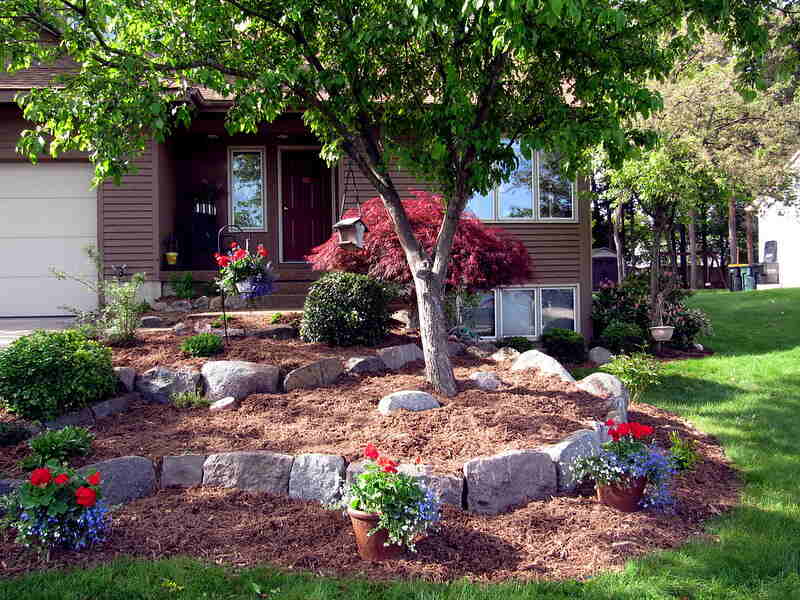
Photo Credit: Rachel Kramer / Flickr / CC BY 2.0
Mulch is essentially a layer of organic, or inorganic, matter that suppresses weeds, helps in breaking down fertilizer, and protects soil moisture in your landscape beds. It’s quite inexpensive and needs no care or maintenance whatsoever. Additional advantages of layering up mulch include reduced soil compaction, erosion control, and soil temperature moderation.
Use two to four inches of mulch around your plants. Organic mulch is made of shredded bark or wood chips that add organic matter to the soil. Mulching your garden beds, shrubs, and trees will facilitate mowing and reduce the chances of damage from string trimmers of mowers to the stem. This will reduce your lawn work by a great deal.
Advantages of Mulch:
- Saves water by encouraging plants to retain water
- Limits weed problems
- Adds a pleasant aroma to the landscape
- Protects soil in heavy rainfalls
6. Reduce Size
Home landscaping looks and feels more intimate if you keep it small and cute. If you’re looking to create a low-maintenance lawn but don’t have the time to keep a manicured look, maybe consider downscaling it a little.
It takes no time to plant a flower garden or colorful vegetable, but it takes considerably more time to keep it healthy, watered, and harvested. You can reduce the size of the maintenance-needing part of your landscape by turning it into a container garden or putting in small potted plants.
They are easier to look after and you can move them around to refresh your landscape view any way you feel like.
Advantages of Reducing Landscape Size:
- Upkeep is less time-consuming
- Saves water, time, and money
7. Keep the Design Simple
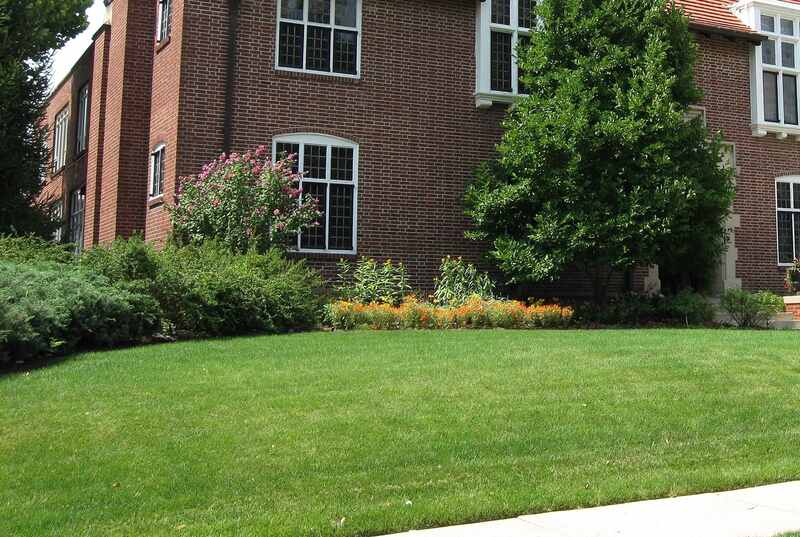
Main Image Credit: HornColumbia / Wikimedia Commons / CC BY-SA 3.0
The simpler your landscape is, the easier it is to look after it and maintain your curb appeal. Low-maintenance landscaping involves clean designs and fewer features that won’t require a village for periodic cleaning and care.
If your lawn has frills such as water features and statues, eliminate them or redesign them for easy care and maintenance. Also, avoid over-planting so you don’t have to constantly spend time and money on pruning.
Plant several different kinds of plants for more texture and color in your landscape, but make sure you don’t go overboard as it may create a busy appearance.
Advantages of a Simple Design:
- Plants can grow to their full sizes when you don’t overplant
- Easy to keep larger plants within bounds
8. Create More Outdoor Living Spaces
Creating more living space and limiting the grassy areas in your landscape can save you time and energy spent on tending to a lawn. You can do so by building a nice grilling area, deck, patio, fire pit, or outdoor dining area where you can enjoy with friends and family.
Advantages of Outdoor Living Spaces:
- No maintenance is required, only periodic cleaning
- Long-lasting features
- Saves water, fertilizer, and all plant-related expenses
9. Try Xeriscaping
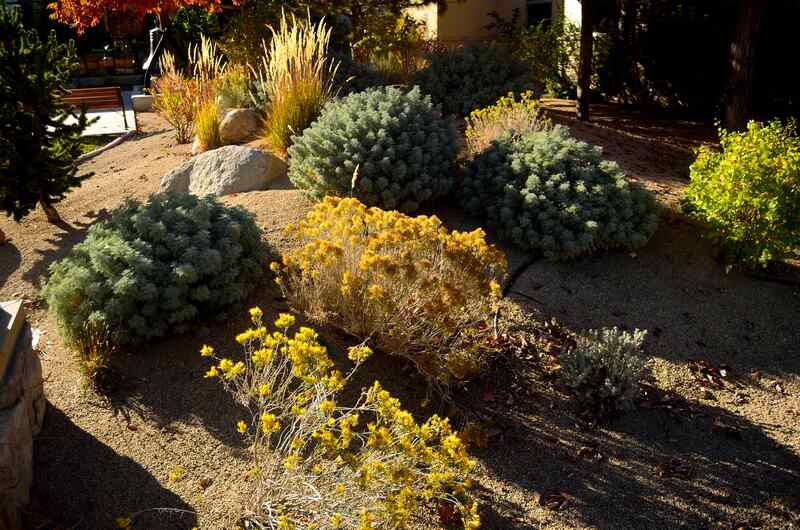
Photo Credit: Tom Hilton / Flickr / CC BY 2.0
Xeriscaping is a design approach that assembles a landscape in a way that limits or eliminates the need for irrigation. This method mostly uses drought-tolerant plants and hardscaping features to promote water movement only to areas where that need it.
After xeriscaping, your landscape will do just fine with the water it receives from natural rainfall. But before plan, consult a professional or research thoroughly on how to prep for xeriscaping since it can be a long process.
Advantages of Xeriscaping:
- Conserves water and reduces irrigation costs
- Great for the environment – preserves water resources
- Time-saving
10. Use More Perennials
Perennials are known for their hardiness and ability to stick around all year round. When you’re choosing flowers or grass beds for your Missouri landscape, make sure you plant plenty of perennials instead of annual plants.
With annuals, you have to replant them every year but they continue to grow all season long. This is not the case with perennials. You won’t have to replant them every year, perennials simply go dormant and come back to life once their blooming season arrives, year after year. However, they may bloom for a shorter period compared to annuals.
A few popular perennials you can use:
- Hibiscus
- Bee balm
- Camomile
- Daisies
- Hostas
- Cypress plant
Advantages of Planting Perennials:
- Last for decades
- Maintain soil moisture
- Easy to propagate and care for
Don’t Know Where to Start With Your Low-maintenance Missouri Landscape?
These 10 tips to create a low-maintenance landscape may look too much but are pretty doable if know what you want and how to do it.
But if you don’t, you can always reach out to a local pro at Wikilawn to help you plan and execute a low-care landscape for you.
Main Image Credit: Paul Sableman / Flickr / CC BY 2.0